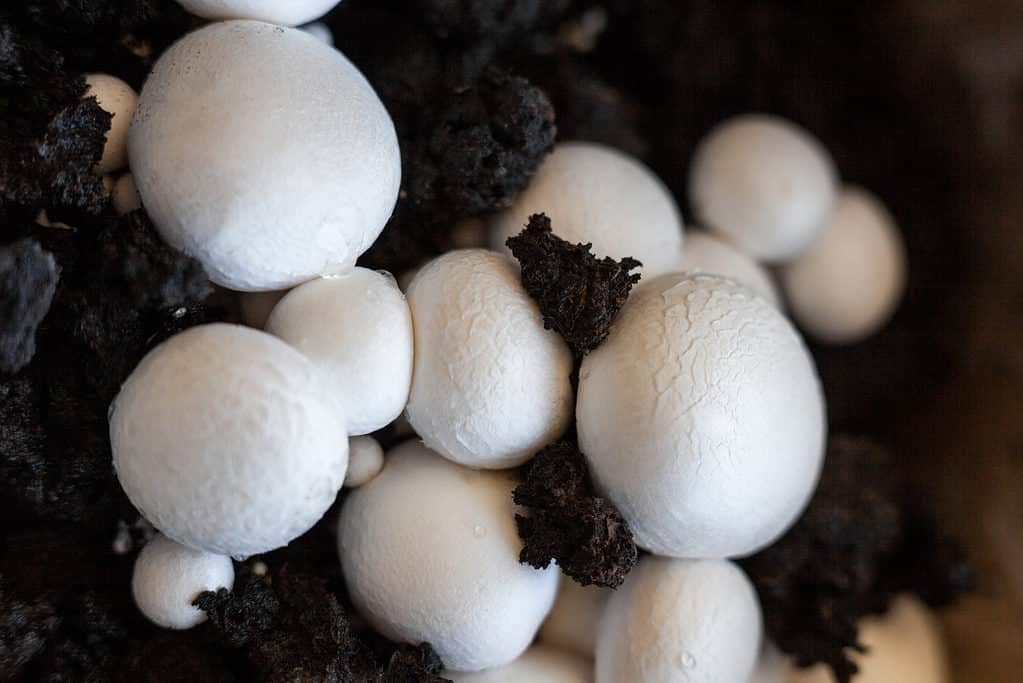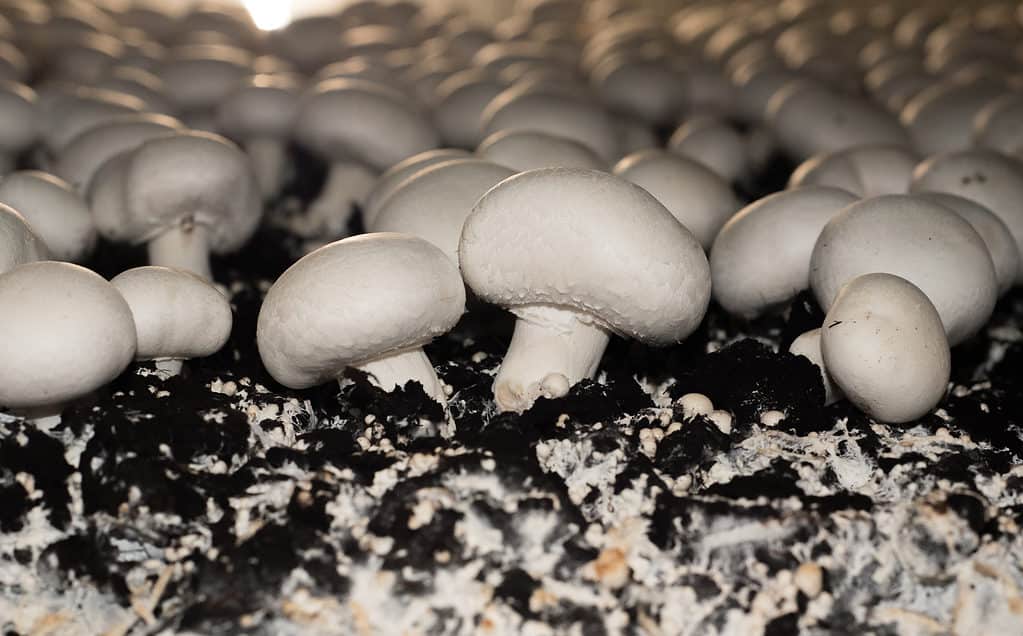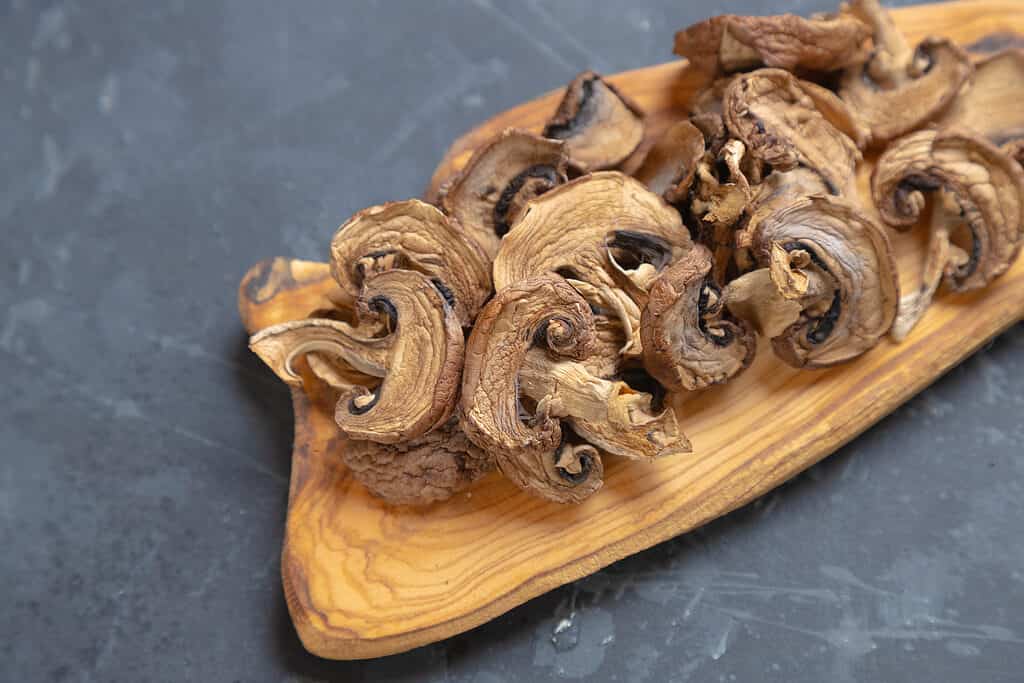When you think of button mushrooms and baby bella mushrooms, you likely think of two very different-looking mushrooms. However, did you know that these are both from the same species of fungus? Both go by numerous different names, leading many people to believe that they are different species. However, they are actually the same species harvested at two different stages of maturity! This key difference does impact many of their features, however, including taste, appearance, and use!
Let’s learn a bit more about both button and baby bella mushrooms now. Let’s go!
Comparing Button vs. Baby Bella Mushrooms
| Characteristic | Button Mushrooms | Baby Bella Mushrooms |
|---|---|---|
| Scientific Name | Agaricus bisporus | Agaricus bisporus |
| Genus | Agaricus | Agaricus |
| Family | Agaricaceae | Agaricaceae |
| Division | Basidiomycota | Basidiomycota |
| Kingdom | Fungi | Fungi |
| Common Name | Buttons, white button mushroom, white mushroom | Swiss brown mushroom, Roman brown mushroom, Italian brown mushroom, crimini mushroom, chestnut mushroom, baby bella mushrooms |
| Origin | Asia, Europe, and North America | Asia, Europe, and North America |
| Description of Fungus | The youngest mushrooms harvested are called button mushrooms. Button mushrooms are white, mild in flavor, and small (between half an inch and 3 inches across). | Baby bella mushrooms are also harvested while immature, though at a slightly older stage (about 40 days) than button mushrooms. They are shades of tan to darker brown, earthy in flavor, and typically grow to be between 1 and 3 inches across. |
| Harvesting Period | Button mushrooms may be harvested after seven to 14 days of growing (after the mycelium initially sprouts). | Baby bella mushrooms may be harvested after about 40 days of growing. |
Descriptions of Button and Baby Bella Mushrooms
Both button mushrooms and baby bella mushrooms are Agaricus bisporus, an edible fungus. Agaricus bisporus is cultivated around the world. This species of fungus is one of the most popular mushrooms for human consumption. The fungus is harvested at different stages of maturity. Button mushrooms are harvested in the immature, white stage of maturity. Baby bella mushrooms are brown and slightly older, but are still considered to be immature.
Agaricus bisporus is not commonly found in the wild. They grow naturally in damp, fertile soil. When cultivated, the fungus grows well in a mixture of compost and animal manure. In the wild, the mushrooms grow from spores or existing colonies. Spores are asexual “seeds”, which do not have any endosperm. Therefore, in order to grow, a spore must land on organic material that is in the right stage of decomposition, such as manure or compost. This provides food for the germinating spore. When cultivated, the spores are normally grown out as spawn before being added to the substrate.
Description of Button Mushrooms
Button mushrooms are the smallest most immature form of the fungus Agaricus bisporus sold in stores. As the youngest form, cultivators harvest button mushrooms when they are between 1 and 3 inches across, white, and mild in flavor. However, most are very small and harvested when less than half an inch across.

Button mushrooms are the most immature form sold of the fungus
Agaricus bisporus.©rootstock/Shutterstock.com
Description of Baby Bella Mushrooms
After growing for 40 days, baby bella mushrooms are harvested. As a more mature version of Agaricus bisporus, they are bigger and have a firmer texture. Their color can be dark or light brown and carry an earthier flavor. They are typically harvested when around two inches in diameter, though they grow to be between one and three inches across.

Baby bella (Agaricus bisporus) mushrooms are harvested later than button mushrooms so they are bigger, firmer and their color is darker.
©Jstengel/Shutterstock.com
Key Differences
As the same fungus harvested at different periods, button and baby bella mushrooms share many traits. They share similar histories, cultivation needs, and culinary purposes. They also have a few differences. Each has its own appearance, taste, and uses. Let’s discuss these similarities and differences in greater depth now.
Button vs. Baby Bella Mushrooms: History
Though mushrooms have been by the Chinese for at least 800 years, they gained popularity in modern times dating back to early cultivation in the 1500s. Large-scale commercial production in Europe took off in the 1600s. This is when farms began producing the mushrooms and European production started to become a leader in global production and consumption of the button and baby bella mushrooms. At the time, production was mostly limited to certain seasons.
Today, button mushrooms are cultivated on a wide scale in Western Europe, North America (The United States and Canada), and Southeast Asia (China, Korea, Indonesia, Taiwan, and India). Button mushrooms are one of the most widely-consumed mushrooms in the world. They are the youngest form of Agaricus bisporus that is sold to the public, and are the species that comprises approximately 40% of mushrooms cultivated globally. However, baby bellas and portobello mushrooms are also popularly grown and eaten around the world.
Mushrooms in the Agaricus genus are the leading mushroom crops worldwide. In 2017 and 2018, they accounted for a whopping 97% of U.S. mushroom production!
Button vs. Baby Bella Mushrooms: Appearance
Button mushrooms are also called white mushrooms, common white mushrooms, or white button mushrooms because of their pale, ivory color. They can be very tiny or as large as 3 inches in diameter. These mushrooms have smooth and rounded top caps, with flesh that is slightly sponge-like while staying firm. Underneath the caps are light brown gills, which produce dark brown spores. The stems are short and white.
Baby bella mushrooms also go by several other descriptive names, including brown mushrooms, crimini mushrooms, and chestnut mushrooms. Like button mushrooms, baby bellas are also fairly small. They are often harvested at around 2 inches in diameter, but grow to be between 1 and 3 inches across. They have brown caps, which can be dark or light brown. As the mushroom matures, the cap opens up more to reveal the brown gills underneath. The stems are also short and white.

Button mushrooms have smooth, rounded top caps, and short white stems.
©ArliftAtoz2205/Shutterstock.com
Button vs. Baby Bella Mushrooms: Growing Conditions
Native Growth
Agaricus bisporus is not very common in the wild, but if you do want to look for them they thrive in moist, grassy areas. They grow naturally in damp, fertile soil. They can be cultivated in conditions similar to their natural growing environments. Growing mushrooms is relatively complex compared to growing most vegetables.
Growing Your Own Mushrooms
If you want to grow mushrooms, find a moist, cool place where the temperatures stay between 50 and 70 degrees Fahrenheit. You will also want to ensure that there are somewhat humid conditions. Ideally, the humidity should remain above 70%. Otherwise, you run the risk of your mushrooms drying out or splitting.
Typically, mushrooms grow well indoors. Producers fill trays with manure or a combination of compost or manure. Because Agaricus bisporus grows best in nitrogen-rich manure, you can use cow or horse manure or mix compost and manure.
After fresh compost ferments for several days (often between four and six days), move the trays of compost to a well-ventilated area. From there, you may use “spawn” to propagate your mushrooms. Spawn includes mushroom spores and other materials such as manure or grain, then planted and allowed to spread throughout the entire bed.
Your mushrooms will grow best in warmer conditions, which allows them to spawn, ideally in temperatures with soil around 70 degrees Fahrenheit. But be careful – temperatures hotter than that can kill your culture! Check on your mushrooms often to ensure that they stay moist, spraying them with water if needed.
After several weeks of cultivation (approximately three), a web of mycelium will begin to grow on top of the bed of manure. About three to five weeks later, you should see mushrooms beginning to grow. At this point, they will need continued moisture.
Eventually, you will know it is time to harvest your button mushrooms when their caps pop open. At that point, you can twist them out of the dirt.

Mushrooms can grow very well indoors because ideal climate conditions can be controlled.
©ArliftAtoz2205/Shutterstock.com
Button vs. Baby Bella Mushrooms: Taste
Button mushrooms are some of the mildest in flavor. Some people eat them raw, but they should be cooked to break down any possible gastric irritants or carcinogens and for enhanced flavor. They are often eaten together with other mushrooms that have strong flavors. When cooked, they have a slightly earthy flavor and possess a chewy but tender texture. This makes them an approachable option to eat for those trying mushrooms for the first time.
In comparison, baby bellas have a firmer texture and a more strong, earthy flavor. This makes them useful as a flavor addition in stews or soups and means that they have a good flavor alongside meat and other savory umami flavors.
Button vs. Baby Bella Mushrooms: Uses
People eat both types of mushrooms throughout the U.S. and around the world. You can find them in dried, raw, and cooked forms. Typically, you can buy mushrooms at grocery stores in the produce section. They are somewhat nutritious and sold as a meat alternative for a vegan diet due to their protein content and texture.
They are also sources of vitamins and minerals. These include vitamin D, potassium, copper, and several B vitamins.
Button mushrooms are popular for being nutritious and bringing a mild umami flavor to a wide array of dishes. Restaurant and home cooks often add buttons to pizza, noodle dishes, and soups and stews. You may also find them as a topping for salad. However, you can also find button mushrooms dried and sold to add flavor to soups and dishes such as ramen.
Baby bella mushrooms have many of the same uses in cooking as button mushrooms. Because they bring a slightly stronger, earthy, savory flavor, baby bellas are often used to add flavor and are often an ingredient in pasta dishes and soups.
Additionally, mushrooms have long been used in traditional medicines for a variety of healing and health purposes.
Button vs. Baby Bella Mushrooms: Storage
The cooking magazine Bon Appetit recommends rinsing button and baby bella mushrooms before patting them dry – avoid soaking them in water. Cooks who prefer to not wash mushrooms out of fear of making them absorb too much water may wipe them clean of dirt using a damp towel or paper towel. You may eat all parts of these mushrooms but should trim the tip of the stem before cooking them. Store them in the refrigerator with a damp cloth covering them, but leave room for them to breathe. You should avoid keeping them in plastic bags, which can cause the mushrooms to become overly moist, causing them to soften and turn slimy.
Though it is usually best to eat them within a few days, some cooks suggest storing them in a brown paper bag. This may extend their shelf life.
The majority of whole mushrooms or cooked mushrooms will remain good to eat in the refrigerator for about one week, some even say up to 10 days. When sliced, they will last a shorter period of time. Consider eating your sliced mushrooms before they reach the five to seven-day window. On the flip side, dried mushrooms can last much longer! They can last as long as two to three years. You can also rehydrate your dried mushrooms for soup or other recipes!
You will know when your mushrooms are bad because they will develop slime. If you catch this soon enough, you may still quickly cook your mushrooms. However, if you wait too long and the flesh is soft and covered in slime, it is best to dispose of them and not attempt to eat them.

Dried mushrooms can last as long as two to three years and can be rehydrated for use in soups or other recipes.
©Igor Dutina/Shutterstock.com
In Summary
This article compares the fungus Agaricus bisporus at two stages of maturity: when it is young and mild and when it is slightly more mature and flavorful. Though button and baby bella mushrooms have a lot in common, they also have distinct tastes, appearances, and uses. This sets them apart and makes each one a delicious and valuable flavor for your cooking!
The photo featured at the top of this post is ©
The information presented on or through the Website is made available solely for general informational purposes. We do not warrant the accuracy, completeness, or usefulness of this information. Any reliance you place on such information is strictly at your own risk. We disclaim all liability and responsibility arising from any reliance placed on such materials by you or any other visitor to the Website, or by anyone who may be informed of any of its contents. None of the statements or claims on the Website should be taken as medical advice, health advice, or as confirmation that a plant, fungus, or other item is safe for consumption or will provide any health benefits. Anyone considering the health benefits of particular plant, fungus, or other item should first consult with a doctor or other medical professional. The statements made within this Website have not been evaluated by the Food and Drug Administration. These statements are not intended to diagnose, treat, cure or prevent any disease.
Sources
- PBS, Available here: https://www.pbs.org/food/the-history-kitchen/edible-mushrooms/
- Bon Appetit, Available here: https://www.bonappetit.com/test-kitchen/ingredients/article/white-button-mushrooms
- National Horticulture Board of India, Available here: https://nhb.gov.in/report_files/Button_Mushroom/BUTTON%20MUSHROOM.htm#:~:text=Cultivation%20of%20button%20mushrooms%20(A,the%20world%20production%20and%20consumption.
- Penn State Extension, Available here: https://extension.psu.edu/mushrooms
- University of Florida, Available here: https://edis.ifas.ufl.edu/publication/MV095
Thank you for reading! Have some feedback for us? Contact the AZ Animals editorial team.






